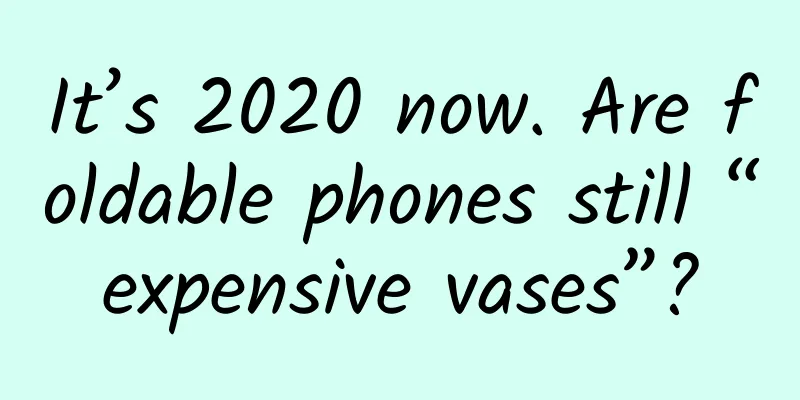It’s 2020 now. Are foldable phones still “expensive vases”?

|
At the Samsung Unpacked conference that just ended early this morning, the Galaxy Z Flip was the first new product to debut at the conference and was also the most expensive product. At the same time as its release, it once again pushed the public's discussion on foldable screen phones to a new climax. At the beginning of 2020, "foldable screen mobile phone" was the keyword for new products in the digital world this quarter: in addition to Surface Duo, at the beginning of the year, new vertical foldable screen mobile phones such as Motorola RAZR were officially launched to attract attention, as well as the foldable screen flagship Galaxy Z Flip that attracted much attention at Samsung's global launch conference. Aside from the noise, there is no shortage of questioning voices: the main arguments of the skeptics focus on the weaknesses of current foldable screen phones: the immature hinge and screen technology, as well as the high prices that are enough to discourage ordinary consumers. To be fair, these doubts are justified. As a new thing, foldable screen mobile phones are themselves a symbol of high technology and craftsmanship. Every news about the Galaxy Fold falling below the market is extremely eye-catching. Moreover, the Galaxy Fold's screen does require users to take good care of it, as if it is not a daily communication tool but an expensive scientific research equipment. Even so, there are still many problems restricting the development of foldable screens. The characteristics of the under-screen camera technology and the foldable screen material itself are all reflected in the Galaxy Fold phone: Want to use it normally? You need to first accept the large area in the upper right corner of the screen for placing the camera module and the "groove" in the middle of the foldable screen. Judging from the current situation of the upstream folding screen industry, it is unrealistic to sell folding screen phones at the current flagship price of 4000-5000. Although most people will call it expensive when they see the price of Galaxy Z Flip, when you react a little and compare it with the folding screen phones that have been released, you will find that the cheapest folding screen phone on the market is Galaxy Z Flip (priced at US$1,380, about RMB 9,612)! Even Motorola RAZR costs US$1,499.99 (about RMB 10,456). It seems that the high price has really become the original sin that folding screen phones cannot escape. At the same time, due to the temporary absence of optimization of the underlying Android system for foldable screen mobile phones, both Huawei and Samsung are actually independently carrying out system optimization work for foldable screen mobile phones in 2020: the ideas are also different: Huawei provides foldable screen mobile phones with the "Parallel Vision" function in its own tablet products. You can open the sub-level content (such as a chat window with someone) while retaining the current level content (such as a chat list) in the same App. Samsung's idea is to place as many apps as possible on the large screen to meet users' multitasking needs. According to this research and development idea, Galaxy Fold allows apps to freely scale the size of an app on the main screen, and can also place three apps on the main screen at the same time. The foldable screen market in 2019 experienced several release delays, and after the release, the release had to be postponed again due to after-sales problems caused by large-scale peeling of the screen protective layer. Finally, the foldable screen mobile phone ushered in 2020. Foldable phones in 2020: new positioning, new market Entering 2020, after the first generation of foldable screen phones had been complained by users for half a year, new products such as Motorola RAZR and Samsung Galaxy Z Flip are attracting much attention in 2020. At the same time, Microsoft Surface Duo will also be officially released at the end of 2020. We don't know the specific sales of each foldable phone in 2019, but a significant change from the new products released in 2020 is that the development direction of foldable phones has reached a "crossover": from Samsung's Galaxy Z Flip advertisement inserted during the Oscars ceremony, to Samsung and the well-known fashion designer Thom Browne's eponymous fashion brand jointly released a customized version of the Galaxy Z Flip, Samsung's 2020 foldable phone strategy is already very clear: since foldable phones cannot be sold at a low price to ordinary people for the time being, it is better to take advantage of the public's already formed mindset and add unique "fashion items" to foldable phones, opening up a new market for the new generation of foldable phones. Judging from the fact that Motorola RAZR also recently released a gold version, Samsung is not the only one that has the idea of adding foldable screen mobile phones to the attributes of fashion consumer products. Both companies have adopted a vertical folding design that can better protect the screen. In other words, they have chosen to abandon the 2019 feature of "foldable screen mobile phone is an Android tablet when unfolded", and move from exploring attributes to pursuing practicality: even when the vertical foldable screen mobile phone is unfolded, it is just an Android phone with a relatively large screen ratio, which naturally bypasses the problem of App adaptation on the large screen. Freeing themselves from the stereotype that foldable phones are expensive toys for geek enthusiasts and Android in 2019, and giving them more attributes, is another step for Samsung and Moto to explore on the road of foldable phones. At the same time, giving up some radical designs on foldable phones so that they can have more reliable quality and lower prices is also a trade-off that mobile phone designers have to make: if they want foldable phones to continue to be popular for a long time, they must first be recognized by consumers and the market. The Surface Duo is the forerunner of the other path mentioned above. As Microsoft's first product in the field of mobile Android devices, Microsoft also chose to abandon radical design in exchange for a more practical and reliable experience: this is also the main reason why the Surface Duo consists of two screens instead of a whole folding screen. In the most basic Android system, Surface Duo still uses the same operating logic as foldable screen phones. For example, in multitasking mode or displaying one content on two screens at the same time, Surface Duo is trying to bring the existing Android interaction logic to the large screen as authentically as possible. Although this reduces some of the novelty compared to Samsung and Huawei's "starting from scratch" in 2019, it actually reduces the learning cost of foldable screen operations, while subtly improving user efficiency and the workload of developers to adapt their apps to foldable screens. At the same time, Microsoft also released the Surface Duo developer kit (SDK) in early 2020 to make it easier for Android developers to adapt their apps to the folding screen operating logic, rather than continuing to rely on the weak Android tablet ecosystem. In the first two months of 2020, Samsung/Moto and Microsoft have chosen their own paths in foldable phones with actual products: abandoning the large-screen advantage brought by the foldable screen, and doing the opposite, "shrinking" the foldable screen phone; or directly abandoning the foldable screen panel with immature technology and using two screens instead. But no matter which development path is taken, a common feature is that the foldable screen phones released this year are trying to use new forms to circumvent the shortcomings of the foldable screen, and explore the future of foldable screen phones as much as possible within the existing frameworks. Although the current foldable screen mobile phones are less sci-fi than the first generation Galaxy Fold and Mate X, they maintain the characteristics of the foldable screen while retaining the unique selling point that can attract consumers. At the same time, they are more practical. In my opinion, 2020 will be the first year that the foldable screen mobile phone market will begin to grow gradually. Even though it has been a year since the release of Royole's first foldable screen phone. There is still no fixed template for foldable screen phones. Various mobile phone manufacturers have created various foldable screen phones based on their own research and development results. TCL has announced 5 verification machines using foldable screen technology in one go, covering almost all the conceivable appearances of known foldable screen phones, including the brain-opening "Z" three-fold prototype. Even Apple, which has not made any moves in the field of foldable screens, recently released a patent showing that Apple is working on solving the problem of foldable screens leaving creases when folded; this at least proves that Apple is conducting relevant research on foldable screen phones; however, according to Apple's style, if a technology is not truly mature, it will not be rashly added to new products to reduce user experience. The current scene of a hundred schools of thought in the foldable screen mobile phone market is very similar to the endless new designs of feature phones launched by various mobile phone giants in the 2000s; because there is no standard answer, every answer may be the correct answer. As for the optimization of the Android system for foldable screens, it is another upgrade focus for foldable screen phones in 2020: At the 2019 I/O Developer Conference, Google first proposed Android 10's optimization of the foldable screen system. Since then, there have been endless discussions about how Android 11 should be optimized for foldable screen devices. As an internal system, it is a key factor in determining whether a foldable screen phone will become a "vase". With more and more mobile phone manufacturers joining in, the adaptation of Android apps to foldable screens has become more and more urgent. There are also companies like Microsoft that are ahead of the curve and provide help to developers themselves, just so that developers can make the App ecosystem better before Surface Duo is officially launched. As the main development company of Android, Google is also working with companies such as Samsung and Huawei that have extensive experience in the field of foldable screen phones to work together to better adapt the next generation of Android systems to foldable screen systems. At the I/O conference in May this year, we will be able to see more information about the Android foldable screen ecosystem. In the rest of 2020, there will be more mobile phones using foldable screen technology, and there may be more amazing new ideas among them, but in 2020, foldable screen mobile phones will get rid of the previous shackles and gain real development; after the technological breakthroughs in the industrial chain and the full development of the Android foldable screen ecosystem, foldable screen mobile phones can truly change the way we use mobile phones. Maybe by then, the "mobile phone" as a communication tool itself will also be replaced. |
<<: Surprise! The log specification I set was promoted by the CTO throughout the company
>>: You can now turn off the "Renewal Receipt" reminder in the App Store
Recommend
Is baby cabbage the baby of Chinese cabbage? Then whose “baby” is baby cabbage?
How to distinguish Chinese cabbage, Chinese cabba...
Sony HT-S500RF review: Turn your living room into a home theater in seconds with a 5.1-channel soundbar
If you want to turn your living room into a home ...
Beware! A child was buried alive while digging sand on the beach. This seemingly relaxing game may actually be a deadly risk.
Edit: Thanks Digging sand on the beach can defini...
The turbulent power battery market: How can we stand out?
The prospect of continued rapid growth in electri...
Private Domain Traffic: The Secret to Transaction in Moments
The Internet traffic dividend has reached its pea...
5 minutes to quickly build an iOS App
[[404179]] This article is reprinted from the WeC...
Should I upgrade to iOS 13.6.2 after Apple pushes it? If my phone still works, I suggest not to upgrade.
Not long ago, Apple pushed the iOS 13.5.1Beta ver...
Xiaomi's 46 high-definition posters tell you how to do fan marketing
How did Xiaomi achieve rapid development in just ...
Lin Yao | Reaching more possibilities through scientific research
At the beginning of 2023, the Chronic Disease Man...
I suddenly became lame after a self-driving trip! Doctors remind me: See a doctor immediately if this happens!
Traveling during the holidays is a good opportuni...
From January to August, the domestic market shipped 227 million mobile phones, of which 5G mobile phones accounted for 74.1%
[[425151]] 1. Overall situation of domestic mobil...
Zu Xiaolai - Medium video project nanny-level practical tutorial, video explanation, violent gameplay demonstration
Zu Xiaolai - Medium video project nanny-level pra...
Five keys to a better 5G: Discovering key trends that will impact consumer adoption of 5G
Ericsson ConsumerLab recently released a report t...
How to select products for live streaming sales? 7 practical methods!
With the growing popularity of short video platfo...
How many Tik Tok views are considered popular? Tips to become popular on TikTok
This article mainly introduces how many Douyin pl...









